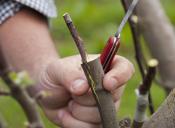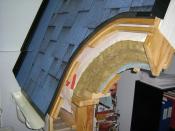Search
Login
Recommended
Design solutions in the garden using stone
Best emphasizes and sets off the delicate greenery of the garden - stone.
Content
- Active use of stone in the design of the garden video
- The use of stone for retaining walls video
- Construction of slides
- Rockeries video
- The use of stone for mulching plants
- Paving tracks video
- Plant selection
Active use of stone in the design of the garden
In recent years, in the vicinity of many cities, stones have almost disappeared from the fields, ravines, and roadsides.
Fans of beautifully designed garden plots gathered all this natural beauty and took it to themselves.
Stone does not happen much.
Any pebble will find its place: wild and processed, small and large, huge boulders and flat plates, cobblestones and pebbles.
If it turns out that you went too far with the stone - help him grow a carpet of green moss.
As a result, you will get velvet green walls or green retaining walls. It is a durable, eco-friendly and beautiful material.
The use of stone for retaining walls
Stones are great for retaining walls. Retaining walls can be made of boulders or large blocks, they can be put on a solution or laid by dry masonry.
which stone to choose: natural or artificial
The use of artificial stone allows the construction of horizontal, vertical and cantilever protruding parts at the same time, which can be difficult to do when building retaining walls made of natural stone.
The main advantage of using artificial stone is the lack of a cast base.
For example, when laying a wall made of natural stone, a special strip foundation is required with racks deepened to the level of freezing of the earth. As a result, the scope of work is often much larger than the apparent area of \u200b\u200bmasonry stone retaining walls, and the number of building materials buried in the ground exceeds all expectations.
This is important: artificial stone makes it easy to erect massive structures in your area.
The universal technology of manufacturing and installation of the structure in place allows you to change the architectural appearance of the garden without injuring the roots of the trees, without spoiling the lawn, which can be perfectly looked after with the oleo-mac lawn mower.
Using artificial stone, it is possible to build retaining walls, spans of bridges, socles, etc.
The installation and removal of formwork, which is specially processed to the texture of the stone, is quick and easy.
In its structure, it is flexible, so the same sheets are used for the manufacture of different shapes and sizes.
After removing the formwork, the resulting forms are processed manually, stained, aged and planted on them with moss.
A team of 4 people, without the use of special construction equipment, can make a large monolithic object in a short time.
This method has gained immense popularity in garden design, especially if the terrain has a gradient of relief and the construction of walls made of natural stone becomes difficult.
The created artificial walls completely imitate the texture of the stone, the sinuous geometry of the walls allows you to restrain the pressure of the earth.
A big plus is the lack of a foundation, it is replaced by crushed stone drainage, so water can freely seep under the wall.
Construction of slides
A large amount of stone is used to create rocky slides and rock gardens.
This is the most common activity among gardeners. In the construction of slides use huge varieties of stone.
But most often they use large fragments of dolomitic limestone, porous shell rock and tuff, denser nergel or sandstones.
Heavier rocks are often chosen: basalt, diabase, quartzite, porphyrite, etc.
When choosing a stone, it is better to give preference to rocks of soft, natural tones.
It is good to use shades of gray, beige or yellowish, as against such a background the plant looks more impressive.
The construction of stony hills pursues decorative goals.
This is important: the structure should look as natural and harmoniously fit into the landscape environment.
Rockeries
The rockeries in which large stones are used look the most natural; it is advisable to use stones with flat or with slightly convex faces.
Several large stones laid uphill look very impressive, but for greater naturalness, they should vary in size and shape.
Mini rockeries look good. They are a type of container. The shape and size of such a rockery is from 20-30 cm. To one meter or more.
Decorative rockeries are arranged in stone flowerpots, and the flowerpot can be made of artificial materials, for example, concrete with the inclusion of large stones.
The use of stone for mulching plants
To mulch plants and decorate seats, to fill the space between large stones, various crushed stone is widely used.
This can be gravel of different fractions, as well as natural gravel, rounded pebbles, fine gravel screenings and coarse sand.
The use of various mineral fillings, in addition to the decorative effect, can strengthen the design of the garden.
With their help, walking paths are built, the boundaries of rockeries, flower beds are beaten off, thus a more holistic perception is achieved.
Paving tracks
For many years, a well-designed, competently and accurately executed paving of paths can be a real decoration of a flat site.
On the modern market there is a huge assortment of sawn and gottered stone slabs, untreated brazing plow, cobblestones, pavers from many types of stone.
This range allows you to implement the most complex paving projects.
In addition to beauty, the use of tiled surfaces helps to save time and effort that is spent on caring for the lawn and other plantings.
Currently, artificial stone is widely used.
Clinker brick and paving slabs made by vibration casting and vibropressing have proven themselves well.
Plant selection
The integrity of the perception of any structure made of stone, largely depends on the correct selection of the assortment of plants.
This is important: one should be guided by the rules of moderation, the subordination of near and distant plans, the naturalness of the whole composition.
In a rocky hill, small woody shrub plants with cushion-like and creeping forms are well combined. Together with low perennials, the effect of a monolithic slide is created, the beauty of the stones used is emphasized.
For stony hills, it is good to use small shrubs, such as: varietal barberries, heathers, spirea, miniature conifers, ground cover roses, carpet perennials, low grasses.
Varieties of cotoneaster horizontal, creeping willow, alpine perennials are planted in crevices and niches between the stones.
Gradually, the hill will disappear under a wave of lush vegetation, but when planting, it is advisable to place the plants so that some of the stones remain visible.





